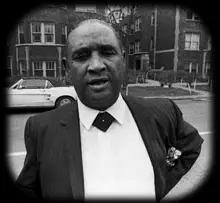
Little Brother Montgomery was a little known but hugely influential Blues pianist from Louisiana. He learned to play piano just after he learned to walk and talk, and his endless stories of his long life on the road and on the club scene made him an invaluable source in the oral history of the Blues. Little Brother had a wide range of styles, from slow, drag-out Blues to ragtime ditties and boogie dance tunes as well as a distinctive vibrato voice, and he also worked with many jazz artists and orchestras, where his good ear for music and his superb memory overcame his inability to read a score.
Eurreal Wilford Montgomery was born in 1906 at Kentwood LA, and he practically grew up in the barrelhouse his father ran next to a lumber camp across the Lake from New Orleans. His resemblance to his Dad, Harper Montgomery, meant the kid picked up the tag ‘Little Brother Harper’ at an early age along with his skill for picking out a tune on the piano. Inspired by his father’s friend Jelly Roll Morton, Little Brother was playing around work-camps and juke-joints before he was even a teenager. Absorbing a host of piano styles on his travels, he was in
Chicago in the late 20s, where he recorded for the Paramount label. His much-covered songs ‘First Time I Met the Blues’, ‘Vicksburg Blues’ and ‘ No Special Rider’ became important Blues standards, if not exactly hits at the time, but as the Depression began to bite, Little Brother returned south, where he spent several years leading his own band in Jackson MS. In 1935-36, he recorded regularly for the Bluebird label in New Orleans, producing more than 20 tracks.
Superb barrelhouse-style piano on ‘Vicksburg Blues’;
By 1942, Little Brother had returned to Chicago, where he would live for the rest of his life. Work was plentiful on the club scene, and his inventive style was a big influence on Sunnyland Slim, the young Otis Spann and many other Chicago pianists. Little Brother’s wide repertoire also gave him the option of playing, recording and sometimes touring with jazz bands: he played Carnegie Hall with Kid Ory‘s Dixieland Band in 1949. In the late 50s, Little Brother backed Otis Rush on his dates on the West side and as the decade turned, he was often heard at the gigs and recording sessions of Buddy Guy. Little Brother’s solo albums from this period,’Tasty Blues’ and ‘Chicago Living Legends’ showed him to be a class act in his own right. In 1969 he set up his own FM label with his wife Jan Floberg (+ Montgomery = FM), and they recorded several albums together.
Little Brother Montgomery Discography
Recorded at The Birdhouse, Chicago in 1961, this is Little Brother in his prime. Mainly a solo performance, LBM is joined by a few excellent sidemen on the jazzier numbers.
CHICAGO; THE LIVING LEGENDS.
He also began to build a reputation in Europe on the Festival and club scene, touring abroad many times. In 1975, Folkways issued an album of Little Brother’s ‘Church Songs’, which enhanced his reputation for turning his hand, and voice, to many styles and brought his output of albums to over 30. Little Brother gave many interviews about his life in the Blues and his endless stream of stories made him a one-man-repository of Blues history, as his remarkable memory gave us insights into the story of the Blues from it’s
origins before WWI almost into the digital age. Little Brother passed away in 1985.
